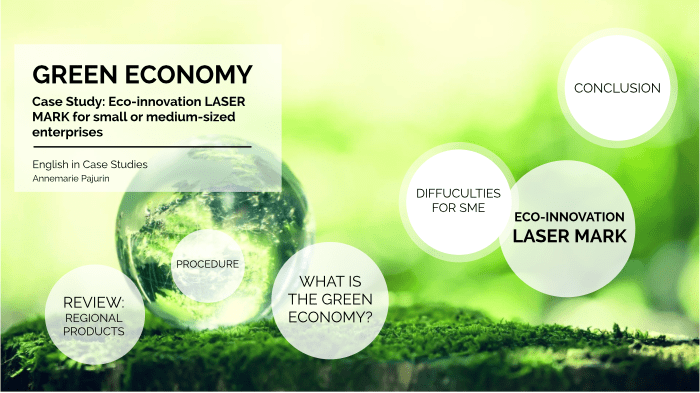Courtesy : hal.science
Green economy innovation
Twenty years after the Rio conference on sustainable development, greening the economy has been
promoted as a new strategy for enhancing human well-being and reducing environmental risk
(Barbier and Markandya, 2013; Pearce et al. 1989). It is seen as a way to implement sustainable
development, amplifying the Agenda 21 (UNEP, 2011: foreword). This vision is generally shared: it
was adopted at the Rio+20 meeting as, it has been
operationalized within the Sustainable Development Goals and their indicators (UN, 2015), and it
relates essentially to mulitlateral multilateral agreements such as the climate, biodiversity and
desertification conventions. Two investment areas constitute key elements of a green economy:
enhancing (i) natural capital, that is, stocks of and flows from agriculture, fisheries, water bodies and
forests, and (ii) energy and resource efficiency, that is, enabling environmental technology in
renewable energy, manufacturing, waste management, buildings, transport, tourism and cities
(UNEP, 2011). Such focus on investments is justified because “investments shape the future of our
economies. Investment decisions choose one type of infrastructure over others, another type of
production or technology over others, which narrows down the options for future choices” (UNEP,
2014a, p. 2). Thus, transforming the economy is understood to be about choices between different
development paths – a far from trivial matter, considering the scale of the challenges and the
changes envisaged. Any economic strategy will require investments, but the normative green
economy vision needs both private and public investment to be steered towards greener and fairer
strategies. It is therefore recognized that such investments have to be “supported by targeted public
expenditure, policy reforms and regulation changes” (UNEP, 2011, p. 16) – which stresses the role of
government intervention.
Reducing environmental harm and social inequality while growing the economy requires a
transformation of existing production and consumption patterns and thus transformations of the
entire economy. The green economy perspective thereby focuses on the
fundamental origin of environmental degradation – namely, the way the economy currently works.
In doing so, it may offer solutions that turn out to be relatively robust against potential setbacks such
as rebound effects. Furthermore, it is a macro-economic approach that, as such, may serve to
promote overarching policies rather than fragmented ones1
. Its beneficial aspects notwithstanding,
the green economy approach entails certain political difficulties with regard to implementation
(Barbier, 2012) as well as high transaction costs (Barbier, 2011). Most importantly, transforming the
economy requires innovation in terms of available technology, organizational support, market
conditions, the broader societal setting, and the overarching governance framework (Barbier, 2011;
UNEP, 2011).
In this paper, we analyse the governance system that may facilitate such innovation and a
transition to a green economy, putting a particular emphasis on government interventions. Our
research question is: How can governance measures support innovations aimed at transitioning
towards a green economy? To this end, we develop a refined model of innovation based on a review
of the existing innovation literature and propose a normative evaluation framework to assess the
transformative effect of an innovation (section 2). Analysing particular measures within the
continuum of innovation stimulating mechanisms, we focus on the role of the state in enabling the
transition to a green economy and illustrate it with evidence from five selected European case
- The transition towards a green economy from a theoretical
perspective: conceptualizing innovation processes and proposing
an evaluation framework
Technological innovations are a crucial component of a green economy transition2
, but ultimately,
such a transition can only be achieved through societal innovation, which has been defined as “a
novel economic and/or social improvement to people’s everyday life […bringing] a (radical or
incremental) systemic change to society’s structures or modes of operation, and is legitimated by the
majority of societal stakeholde. Two aspects of this definition
are particularly striking: i) societal innovation changes the system and ii) it benefits people. On the
basis of this understanding, we hypothesize that any intentional system change (e.g. towards a green
economy) will require some kind of societal innovation. The question of how such innovation can be
fostered in a market economy is vital to understand how a green economy transition can be
facilitated.
One particular (collective) actor who has both ability and legitimacy to steer such innovation
towards sustainability is the government.3
It can set standards and regulation, create the respective
instrument policy mixes, and can thus sanction and incentivize behaviour of private actors – who do
not necessarily have an intrinsic motivation to contribute to a public good of sustainability transitions
(Geels, 2011). While there is a broad body of literature about firm and niche innovations that may
eventually change the system on a broader scale, analyses of politics and the role of government in
societal innovations are relatively scarce (as notable exceptions see Borrás and Edquist 2013;
Flanagan et al. 2011; Geels, 2014; Loorbach, 2010; Smith, 2000; Voß et al., 2009). Thus, we aim to
contribute to the literature by i) refining and extending an innovation governance framework based
on Röpke (1977) in which we locate government intervention, and ii) proposing a basic, twodimensional assessment framework which can measure the transformative effect of green economy
innovations.
2.1. Innovations for a green economy and the role of governance
Societal innovation or regime shifts are keys to turn existing economies into a green economy. To
clarify at which levels such social innovations may occur and take effect we present a stylized
conceptual model in which different systems types and levels of institutions are ordered
hierarchically (see Figure 1). The model is based on an older systemic innovation approach developed
by Röpke (1977), who adopts a Schumpeterian perspective on entrepreneurial behaviour,



